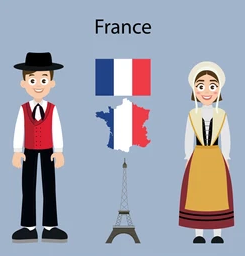France National Dress, known for its rich history, diverse culture, and exquisite fashion sense, has a deep-rooted connection with its national dress. France National Dress, also known as traditional dress or regional costumes, has a long and fascinating history that dates back to the medieval times. In this article, we will take a closer look at France National Dress, its history, evolution, and significance, and answer some frequently asked questions.
History of France National Dress
France has a long history of traditional costumes dating back to the medieval era. In the early days, the traditional costumes were worn as a symbol of identity and social status. During the French Revolution in the late 18th century, the wearing of traditional costumes was discouraged, and people were encouraged to wear modern clothes. However, in the mid-19th century, there was a renewed interest in traditional costumes, and they were once again popularized.
Evolution of France National Dress
The evolution of France National Dress can be traced back to the medieval era, where the traditional costumes were heavily influenced by the nobility and the clergy. Over time, the traditional costumes evolved, incorporating different fabrics, colors, and styles, depending on the region and social status of the wearer. With the advent of modern fashion, France National Dress has undergone a significant transformation, with more contemporary interpretations of traditional costumes emerging.
Significance of France National Dress
France National Dress holds great significance in French culture and history. It serves as a symbol of national identity and pride and is often worn during festivals, cultural events, and special occasions. France National Dress also represents the rich cultural diversity of the country, with different regions having their own unique costumes.
Components of France National Dress
The components of France National Dress vary depending on the gender and region. In general, men's dress includes a shirt, waistcoat, trousers, and a jacket. Women's dress includes a blouse, skirt, apron, and headwear. The colors, fabrics, and styles of the dresses vary depending on the region.
Regional Variations of France National Dress
France is known for its diverse regional cultures, and each region has its own unique national dress. For example, the traditional dress of Brittany includes a lace cap, embroidered blouse, and a long skirt, while the traditional dress of Alsace includes a colorful embroidered vest and a full skirt. The traditional dress of Provence features a colorful skirt and a lace blouse.
Modern Day Interpretations of France National Dress
In recent years, there has been a trend towards modern interpretations of France National Dress, with designers incorporating traditional elements into contemporary designs. For example, designers have used traditional fabrics, such as silk and lace, to create modern dresses and jackets.
How to Wear France National Dress
France National Dress can be worn for special occasions, cultural events, and festivals. It is important to choose the right dress for the occasion and to wear it with confidence. Women may opt to wear a traditional blouse, a long skirt, and an apron, along with appropriate headwear. Men can choose to wear a shirt, waistcoat, trousers, and a jacket, along with a traditional hat. It is important to pay attention to the details, such as the embroidery and fabric of the dress, to ensure authenticity.
France National Dress and Fashion Industry
France is renowned for its fashion industry, and the traditional dress has had a significant influence on fashion designers. Many fashion designers have incorporated elements of traditional costumes into their designs, such as the use of lace, embroidery, and floral prints. France National Dress has also inspired designers to create modern interpretations of the traditional costumes.
Controversies Surrounding France National Dress
France National Dress has been the subject of controversy in recent years. Some argue that the dress is a symbol of French nationalism and exclusion, as it represents a specific cultural identity. Others argue that the dress is a celebration of French culture and heritage and should be respected as such. It is important to recognize the cultural significance of the dress while also acknowledging the potential for exclusion.
FAQs
Q: What is the origin of France National Dress?
A: France National Dress has its origins in the medieval era, where traditional costumes were heavily influenced by the nobility and clergy.
Q: How has France National Dress evolved over time?
A: France National Dress has evolved over time, incorporating different fabrics, colors, and styles, depending on the region and social status of the wearer. Modern interpretations of traditional costumes have also emerged.
Q: What are the different components of France National Dress?
A: The components of France National Dress vary depending on the gender and region. Men's dress includes a shirt, waistcoat, trousers, and a jacket, while women's dress includes a blouse, skirt, apron, and headwear.
Q: Are there any regional variations in France National Dress?
A: Yes, France is known for its diverse regional cultures, and each region has its own unique national dress.
Q: Can non-French people wear France National Dress?
A: While France National Dress is traditionally worn by the French, non-French people can also wear the dress, as long as it is done so respectfully and with an understanding of its cultural significance.
References
- "Traditional Clothing in France." Discover Walks, 2 Feb. 2021, https://www.discoverwalks.com/blog/traditional-clothing-france/.
- "The Evolution of Traditional French Dress." Bonjour Paris, 4 Feb. 2019, https://bonjourparis.com/history/the-evolution-of-traditional-french-dress/.
- "Fashion and National Identity in France." Fashion, Style & Popular Culture, vol. 5, no. 3, 2018, pp. 277-290, doi: 10.1386/fspc.5.3.277_1.
